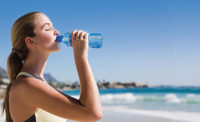Success in Beverages








From sweetener systems to value-added proteins, energy drink and sports beverage formulations require creative solutions.
Marie Spano, Contributing Editor
January 2012/Prepared Foods -- Energy drinks and sports drinks are both mature markets. Therefore, product differentiation, combined with specific consumer messaging, is vital. The solution lies in clearly defining a target market and then combining outstanding taste with specific, research-backed functional ingredients that are a slam-dunk for the consumer. Sweeteners add more than just flavor to sports drinks, and protein is essential for everyone, not just the athlete—a message that is not quite crystal clear to the public. Also, energy drinks should be positioned as either low- or full-calorie beverages that stand out on the shelf with unique ingredients that may affect mental functioning.
Sweet Solutions
When formulating an energy or sports drink, it is important to consider the total sugar content, type of carbohydrates used, calories per serving and the target consumers’ perception of sweeteners. There are two main categories used for sweetening energy and sports beverages: nutritive or non-nutritive. Sometimes, a mix of both may be used to achieve a lower-calorie beverage with the desired taste profile.
For energy drinks, the decision to use a specific sweetener or combination of sweeteners, nutritive or non-nutritive, boils down to desired calorie range, taste and product positioning (“natural” or other). However, in sports drinks, the decision is a little more complex, because athletes have different needs pre-, during- and post-workout—depending on their training, body composition goals and overall energy intake. Therefore, sports beverages are best formulated based on type of training (endurance or strength) and whether the beverage is intended for pre-, during- or post-exercise.
For the hard-working endurance athlete or athlete who is churning through energy reserves quickly, a during-workout beverage with multiple types of carbohydrates (as opposed to just one form of sugar) is preferential. The human body has a different intestinal transporter for each type of sugar. Studies show that during exercise, when one transporter becomes saturated—say the glucose-only transporter—the body’s ability to metabolize and use carbohydrates increases, if multiple types of carbohydrates are ingested1,2. Fructose, galactose and amylose are absorbed more slowly than glucose, sucrose, maltose and maltodextrins. (Galactose and amylose are not prevalent in sports drinks.) Furthermore, beverages with large amounts of fructose can lead to gastrointestinal discomfort during exercise3.
The type of sugar also matters for post-workout beverages, if speed of glycogen replacement is vital (for athletes who train twice a day, hours daily or for endurance athletes). Maltodextrin, glucose and a highly branched, high-molecular-weight glucose polymer solution are the best options for glycogen replacement4.
Though various types of carbohydrates have been formulated into protein-based beverages intended for consumption after a resistance training session (i.e., weight lifting), the need for carbohydrates after resistance training is up for debate. This form of exercise does use muscle glycogen; some have theorized that sugar, when combined with amino acids (alone or within protein), will further augment muscle protein synthesis. This is due to the effect sugar has on insulin release—recent studies have found the addition of carbohydrates does not lead to any additional boost, compared to protein alone, in muscle protein synthesis5,6. Carbohydrates should be added, however, when the target market includes athletes who want to gain mass.
Finally, sports drinks or active lifestyle drinks for seniors may benefit from nixing the carbohydrate altogether and consuming protein alone after resistance exercise, due to changes in insulin sensitivity in muscle tissue in this age group.
Non-nutritive sweetener choices are plentiful. For “natural” product positioning, rebaudioside A, polyols, luo han guo fruit extract and the amino acid glycine are top choices. Polyols vary in their sweetness, and they have a unique cooling sensation that can be overcome when combined with other sweeteners. Because polyols are not completely absorbed, excessive consumption of certain polyols, specifically sorbitol and mannitol, can lead to gas, bloating, cramping and diarrhea. Erythritol is an excellent choice, because it is highly digestible and does not cause a laxative effect. Luo han guo fruit extract, made from the Siraitia grosvenorii Swingle plant, has FDA notification GRAS status. It is 100 times sweeter than sucrose and already is being formulated into some energy drinks.
Additional non-nutritive sweeteners commonly used in energy and sports drinks alike include: sucralose, aspartame and acesulfame-K (ace-K). Ace-K is not a standalone sweetener; instead, it is often combined with aspartame or sucralose.
Protein with a Purpose
Protein has been a mainstay in the sports nutrition world for several years. Protein is primarily used to increase muscle-protein synthesis and decrease muscle breakdown. Though protein may make people think of male athletes and muscle, building and maintaining muscle is critical for everyone throughout their lifespan. This is particularly true for seniors, a population that is growing tremendously (although the market segment for beverages for the active or mature adult has been slow to expand).
The amount and type of protein used varies based on the target market and if the beverage is intended for pre-, during- or post-training. Finally, although sports beverages have performance and recovery in mind, weight control is still a very large influencing factor for the U.S. consumer, particularly women, according to Nutrition Business Journal (2010). Therefore, sports drinks marketed to females should stick to protein and good taste with fewer calories.
Milk proteins—specifically whey and casein—and soy are the market leaders for sports beverages formulated with protein. However, studies examining whey vs. soy found whey has a significantly greater impact on muscle protein synthesis7. Despite this fact, soy is an excellent choice for vegetarian consumers and those who want the added benefit of heart-healthy soy protein.
While adding carbohydrate to protein may not help augment muscle protein synthesis, adding protein to a carbohydrate beverage may further enhance muscle glycogen replacement. This makes the ideal post-workout beverage—for endurance athletes or those in team sports who have used a good part or most of their glycogen stores—a beverage containing both carbohydrate and protein in a suggested ratio of 4:1 or 3:18,9. For this type of athlete, the addition of protein may also decrease post-exercise muscle soreness10 and enhance muscle protein synthesis11.
Brain Power
Caffeine is the primary ingredient in a majority of energy drinks. And rightfully so, since it enhances alertness and decreases fatigue, temporarily. Though the FDA does not require caffeine content to be listed on the Nutrition Facts Panel or label of a beverage, doing so will clearly alert the consumer, thereby decreasing the likelihood of adverse events from unknowingly consuming larger-than-desired quantities of caffeine.
Caffeine, including the many botanical sources of caffeine and its analogs, such as guarana and yerba maté, is a surefire functional ingredient on its own, but the combination of caffeine and l-theanine may offer additional benefits. Both ingredients stimulate the brain, increasing alertness. And, l-theanine also produces a dose-dependent, yet alert state about 40 minutes after it is ingested. This dynamic duo seems to work synergistically to improve some tasks that require acute attention12.
Another point of differentiation for some energy drinks is the addition of citicoline, an ingredient that can improve the structural integrity and functionality of neuronal membranes13. Animal and human studies show that citicoline can improve memory in the elderly14,15. In addition, a double-blind, placebo-controlled study in 60 healthy women, ages 40-60, found 250mg citicoline, taken daily for 28 days, improved attention and responses in a performance test at the end of the 28-day period16. Now the question remains: Can citicoline improve mental functioning after just one dose?
Energy drinks can stand out in their category by clearly targeting a specific market segment (age range, men or women) and adjusting their calorie intake accordingly, while also adding unique ingredients that may boost mental functioning. Sports drinks have evolved through the years from a one-beverage-fits-all approach to drinks that are specifically formulated for endurance or resistance training and used before, during or post-training. For endurance training, the type and amount of carbohydrate matters, and the addition of protein can improve aspects of recovery. For strength training, protein still reigns, and carbohydrate may only be necessary if gaining mass is a primary goal. pf
References:
1. Jeukendrup AE and Jentjens R. 2000. Sports Med. 29(6):407-24.
2. Jentjens RL, et al. 2004. Med Sci Sports Exerc. 36(9):
1551-8.
3. Fujisawa T, et al. 1993. Am J Clin Nutr. 58(1):75-9.
4. Aulin KP, et al. 2000. Eur J Appl Physiol. 81:346-51.
5. Koopman R, et al. 2007. Am J Physiol Endocrinol Metab 293:E833-E842.
6. Miller S, et al. 2003. Med Sci Sports Exerc 2003;35:
691-700.
7. Phillips SM, et al. 2009. J Am Coll Nutr. 28:343-54.
8. Berardi J, et al. 2006. Med Sci Sports Exerc. 38:1337-1344.
9. Ivy J, et al. 2002. J Applied Phys. 93:1337-1344.
10. Luden LD, et al. 2007. Int J Sport Nutr Exerc Metab. 17:109-23.
11. Howarth KR, et al. 2009. J Appl Physiol. 106:1394-1402.
12. Haskell CF, et al. 2008. Biol Psychol. 77(2):113-22.
13. Citicoline, Monograph. 2008. Alt Med Reviews. 13:50-57.
14. Spiers PA, et al. 1996. Arch Neurol. 53(5):441-8.
15. Alvarez XA, et al. 1997. Exp Clin Pharm. 19(3):201-10.
16. McGlad E. 2011. 66th Annual Meeting of the Society of Biological Psychiatry. San Francisco, CA.
Looking for a reprint of this article?
From high-res PDFs to custom plaques, order your copy today!










